
Miramichi and Cains Rivers End of Season Fishing Report
Another year of Atlantic Salmon fishing on the Miramichi has ended. The season closed on Sunday evening October 15 on the lower river, and September 30th for the headwaters.
As a general statement 2017 turned out to be a relatively poor year for salmon fishing on the Miramichi. While there is no question that the salmon run in the Miramichi and many other rivers was down, in the final analysis it was not down to the extent that we feared earlier in the season. When the final counts are in at the end of October we will present a more complete annual recap on the trap numbers. It does appear, though, that in 2017 the better part of the Miramichi run occurred during the fall, contrary to the trend towards a dominant July run that developed a few years ago.
A lack of rain was the biggest issue with this year’s rather strange season. I don’t have my finger tips on the statistics, but I know that we had almost no real rain, and certainly no major raise in river levels from early season until the very end. There was a modest raise around Labor Day from very low levels of about .45 meters on the Blackville gauge up to about .75 meters which is considered the very low end of moderate fishing levels, and then within a couple of weeks we accomplished the unthinkable and the river slipped to just .38 meters in height. No one I can find had ever seen such a low level before. In my limited 15 year experience on the Miramichi I have only seen levels in the mid .4s perhaps three times, and never lower than that, and they never lasted for long until this year.
The results of such a low water level are that many salmon pools simply become unfishable due to inadequate water depth and flow to hold salmon or make them comfortable enough to take a fly. At Campbell’s Pool we did catch fish all the way down to .38, but it wasn’t great. We had an area about 150 feet long and 60 feet wide at the bottom of the pool where we had enough flow to bring the fly around fairly quickly. A few fish held here, and every now and then we got one.
An interesting phenomena occurred in the very bottom of the pool starting just below the stretch that was still fishing reasonably well. There the water deepens and slows down into a small lake extending down river about a thousand feet to the abutment left over from the old Keenan swinging bridge. Salmon and grilse were holding at the upriver end of this lake in some decent numbers. You could watch them repeatedly rise in different areas of the channel. It was slow enough, and deep enough, though that none of the many flies, sinking tips, strip retrieves etc. that we tried would work to catch any. It was great to see them, though, and there were some excellent specimens among them. When the height of water increased just a tiny bit they no longer held there.
During the fall we normally fish the Cains a good portion of the time. The general pattern that we’ve observed on the Cains is that the run stacks up in the section of the river downstream of Salmon Brook from mid-July through late August, and then, depending on rain, creeps up towards Muzzerol Brook area through the middle of September. Normal fall rains gradually increase the height of water in the river, and in late September the main runs heads for the upper river to spawn. Just like in the main river, though, they don’t all do the same thing at the same time. Some fish are still coming in the bottom of the river, and depending on the year you can have good fishing in many pools all along the Cains through the end of the season. This has been what we think of as the normal pattern, though the exact timing and location of the fish is subject to considerable fluctuation year to year. During the summer of 2017 the water was generally not critically hot, but it was warm virtually all summer, and it was continuously too low for good fishing. While temperatures cooled starting in late August, the water level never really got up to normal, and fishing on the Cains was marginal at best right to the end of the season.
On Labor Day weekend a decent rain fell over the entire Cains and Miramichi watersheds that brought the main river up from .49 to .74 on the Blackville gauge. .74 is good fishing water, but it isn’t much for the top end of a raise. The ground was as dry as an old sponge, and it just soaked up much of the water. Between 9/5 and 9/11 two parties of three arrived at Campbell’s for 3 days each. These folks had bought trips that I donated to MSA auctions. They had decent catches of salmon and grilse – mostly grilse – at the Brophy Pool on the Cains, and also the main river. Water temps were in the low to mid 60s. Some of these fish were caught on bombers. The number of fish present though was just a shadow of what we might have hoped for when a decent raise arrived after such a protracted drought.
I arrived on 9/15 along to meet guests Stephen and Audrey Prucnal who have been fishing Campbell’s and Keenan’s since Herb Wade’s day. The river height was already back to its low of the summer .42, and water temperatures were up to the mid-high 60s. There were a fair number of fish holding in the main river – the Cains was too low to fish – and a few new fished moved through every day. These fish were all, though, very tough to catch. We worked very hard for the couple of small salmon that Stephen caught. The next week was one of terribly low water and brilliant sunny days. Mercifully I had to run home for part of it, but the next fish caught was on 9/23 at .39 meters of height and a water temperature of 69F – ultra low and far too warm for that time of year.
The last week of September, statistically in recent years the best of the fall fishing, brought us the lowest water of the fall. This is when levels dropped to .38. I had three guests in camp and that 150-foot stretch at the bottom of our water became very small. We had heard that there were a large number of fish holding down in the big tide pool at Quarryville, so we decided to have a look and give it a try. We were quite delighted to find that there were indeed a lot of fish at Quarryville, and that provided us with a place for a few sessions to take a little pressure off our home pool.
Our first good break came on 9/29 when an inch or so of rain fell along the Miramichi. Because the heaviest rains were in the headwaters with lesser amounts to the east the raise was slow in coming, and in the end it amounted to just 9 inches bringing the river from .38 meters in Blackville up to a modest .65. Normally we would have come up much more than that, but again the ground was so dry it just didn’t happen. Most of the Cains, though, missed the brunt of this storm, and only 3mm fell in the Cains headwaters of Bantalor. The raise on the Cains upriver of Muzzerol was more or less zero, and only an inch or two down at the mouth.
On the Miramichi the raise to .65 meters was a big help. We saw a considerable number of fish run up the river on 10/1 and similar but progressively lesser number each of the next two nights. This created excellent catches of large fish in some of the big holding pools such as the one shared by Black Brook and the public pool nicknamed Pool 66 as the resident fish prepared to move out, and a fair number of bright, sea-liced salmon moved up the river from the estuary.
Here is Mike’s hen swimming off after her release.
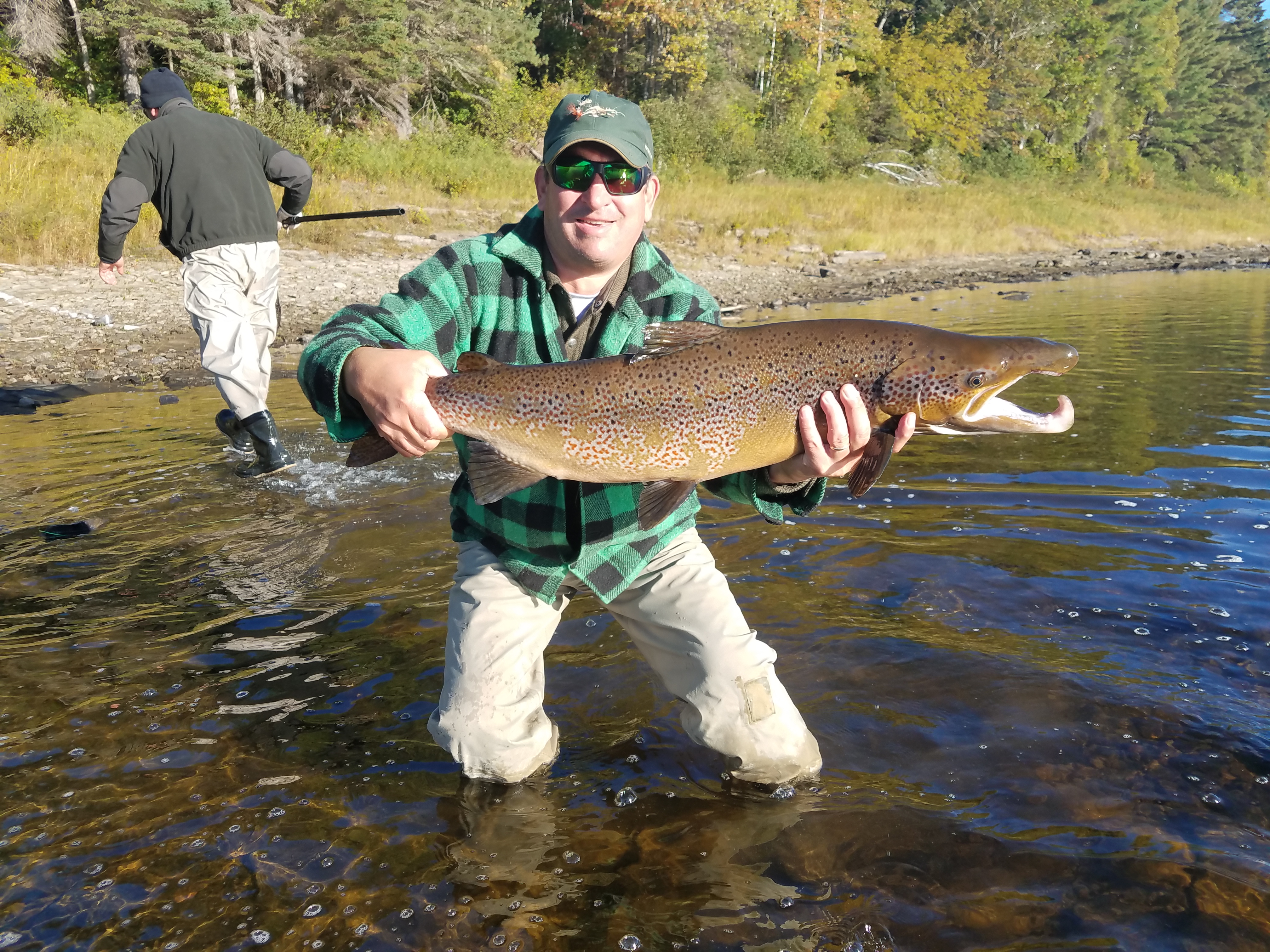
John Vickery Jr. with a great hookbill from Pool 66 across the river from the Black Brook Salmon Club.
Most people, caught fish for a couple of days after that raise, but not on the Cains. By the 5th the water level was back to .45 meters and the flow had slowed dramatically. At that level every inch really makes a difference in the push of the river.
One thing this low water gave us was the chance to play with very small flies and light tippet. One of my favorites, the Sneaky, was for us the hero of the day. I tied some of these on #10 hooks with 6 or 7 hand-counted strands of bucktail and two strands of small diameter krystal flash. It worked better for us than anything else. I fished the Sneaky with a 14’ Spey rod, using a 16-foot tapered leader ending in 6 pound test. It worked occasionally, but it was very hard to hold on to a hot fish with the tiny flies. On the evening of October 1 I had three nice salmon on the line that all managed to get off.
When the water came up just a bit and increased the flow I moved to a #8 or #6 Ally’s shrimp which I felt had just a little more presence in the water due to the water damming of the collar hackle and pheasant tippet wing. Some of the Scottish fishing experts believe that 53F is the temperature at which a long-tailed fly is superior. While it may not be as precise as that, I think the salmon prefer a long fly when the water cools enough in the fall regardless of water height.
My change of pace fly in the low water conditions was a tiny Green Machine tied with ultra-chenille rather than spun deer hair. This fly has been a killer for me in summer warm water and is detailed in a blog from August 2016.
Looking at the fly photo a standard issue, very sparse Sneaky is on top, next is a Sneaky substituting a tail of ultra-mobile goat instead of bucktail, third down is an Ally’s shrimp, and then the ultra-chenille Green Machine.
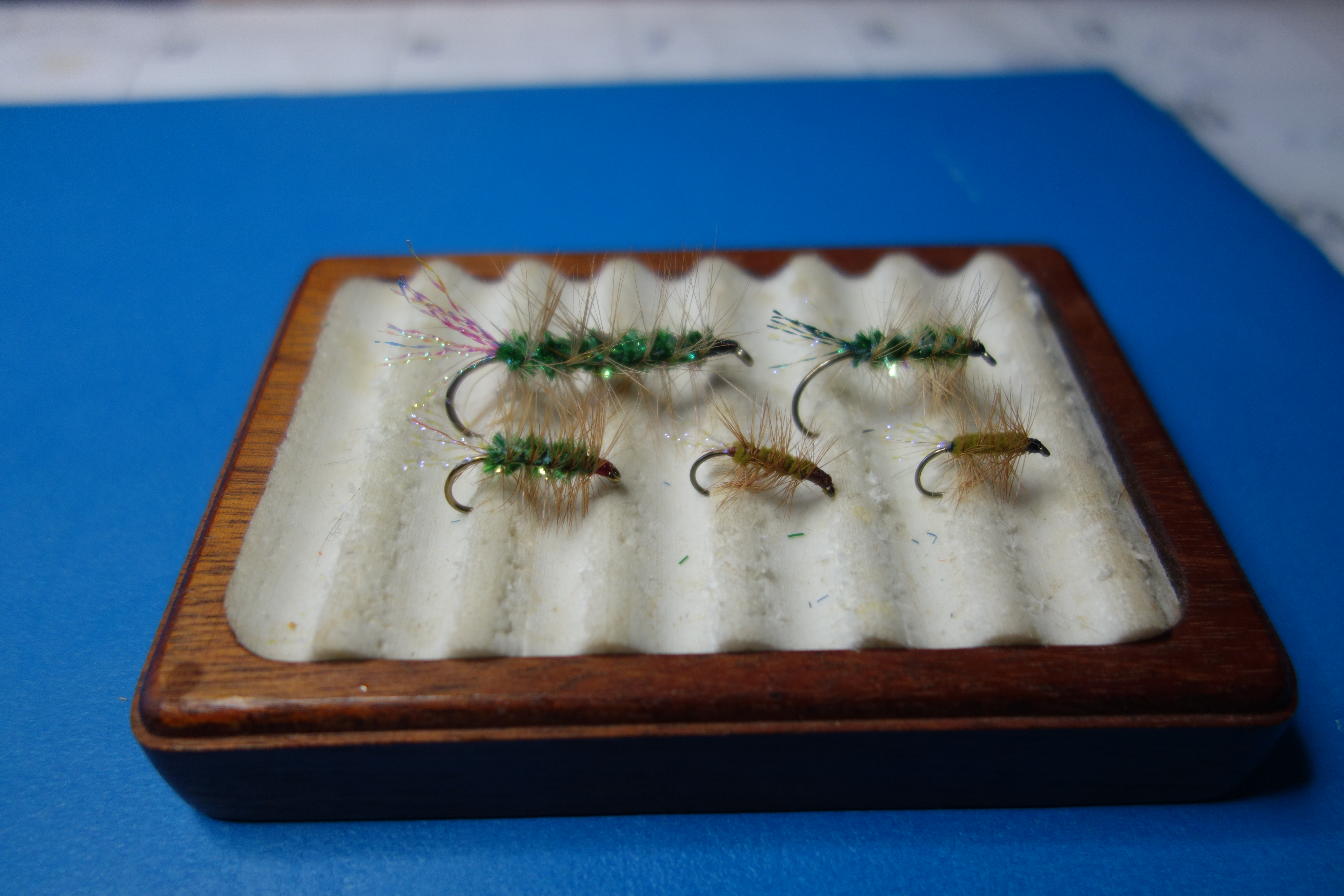
Three different sizes of Flash Chenille Green Machine aka Yum Yum and two ultra chenille green machines for skinny water.
A popular fly during the hot fishing at Black Brook was the Yum Yum. This fly was developed by Willy Bacso and myself circa 2004. Willy had the idea that we could get around the standard Green Machine’s tendency to break the surface during the swing by tying our flies using chenille. I saw some flashy variegated chenille at LLBeans and used that for some flies instead of the standard drab chenille and the current version of the fly was born. I gave some of these to BBSC member Rip Cunningham to repay him for a collection of Hardy feather wing salmon flies that I mounted and displayed at Campbell’s. We call the fly a Flash Chenille Green Machine, but BBSC fishermen decided that salmon liked it enough to rename it the Yum Yum which sounds appropriate enough to me. I saw that the Curtis Fly Shop in Blackville is now tying and selling them. I tie most of my Green Machines with a somewhat stubby krystal flash tail. I also like a tail of white bucktail that is sparse and tapered, and is about 60% as long as the flies body. The photo shows a small collection of variously configured Flash Chenille Green Machines or Yum Yum flies.
The change we were hoping for came on 10/8. This day began as warm, densely overcast, and it rained hard for about three hours in the late afternoon as the cold front came through. The water started to raise immediately and we had a little action as the fish quickly reacted to it. This rain amounted to a little over a half inch for most of the watershed including the Cains.
The next day we got more good news that we would get a good hit from the remnants of hurricane Nate, and we also heard that the Millerton trap was showing excellent numbers of sea-liced fish. We hoped for all of our dreams to come true on the Cains and the main river. The short of it is, though, that it just didn’t materialize as we hoped. The Miramichi ended with a decent raise up to about 1.05 meters, but the severely parched Cains above Muzzerol Brook just never really responded adequately with water levels remaining well below what we would normally think of as minimal fishing levels. Incredibly it was already down to .6 meters and getting low again when the season ended on 10/15. We did see and catch fish on the main river. The fish we saw were very fresh and took the fly readily, but there were just very few of them. We heard conflicting reports from further down river about solid numbers of sea-liced fish, but in Blackville we just didn’t see very many of them. I will say that in the afternoon as the season closed several large salmon made their way through the pool, and it left me quite hopeful that in the next few days even more would show up and add to the spawners already on the grounds.
When the final trap numbers for Millerton are in after 10/31 we will have a much better idea of what came in after the season and how the total numbers compare to recent years. I’ll post a new blog then with the results of that data. Now we just have to adjust to life without salmon fishing for a few months – no easy task for me…
Here are a few fall fishing shots that you may enjoy:
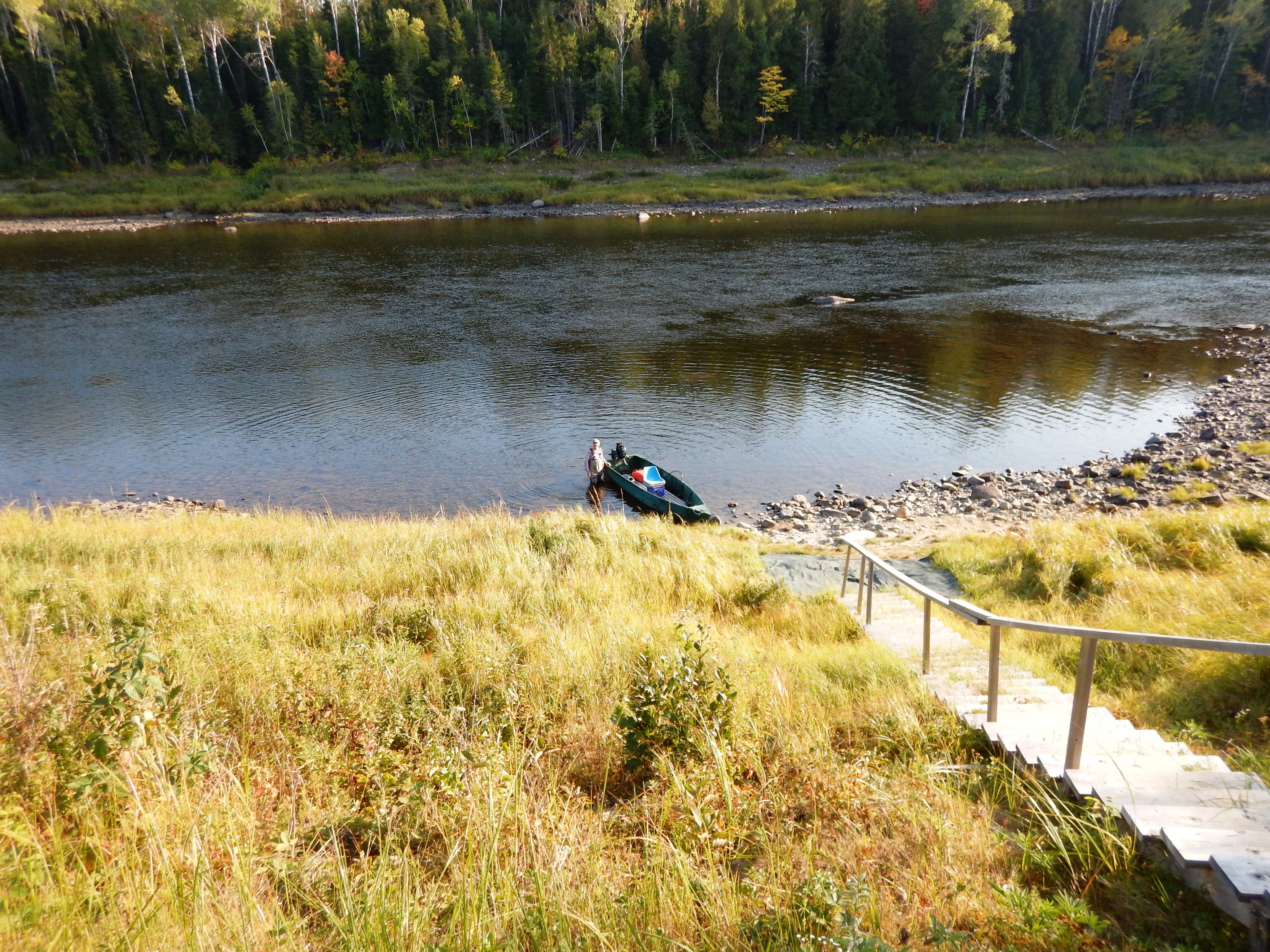
Arnie Curtis, son of Ted Willams guide the late Roy Curtis waits to ferry sports across Black Rapid’s home pool.


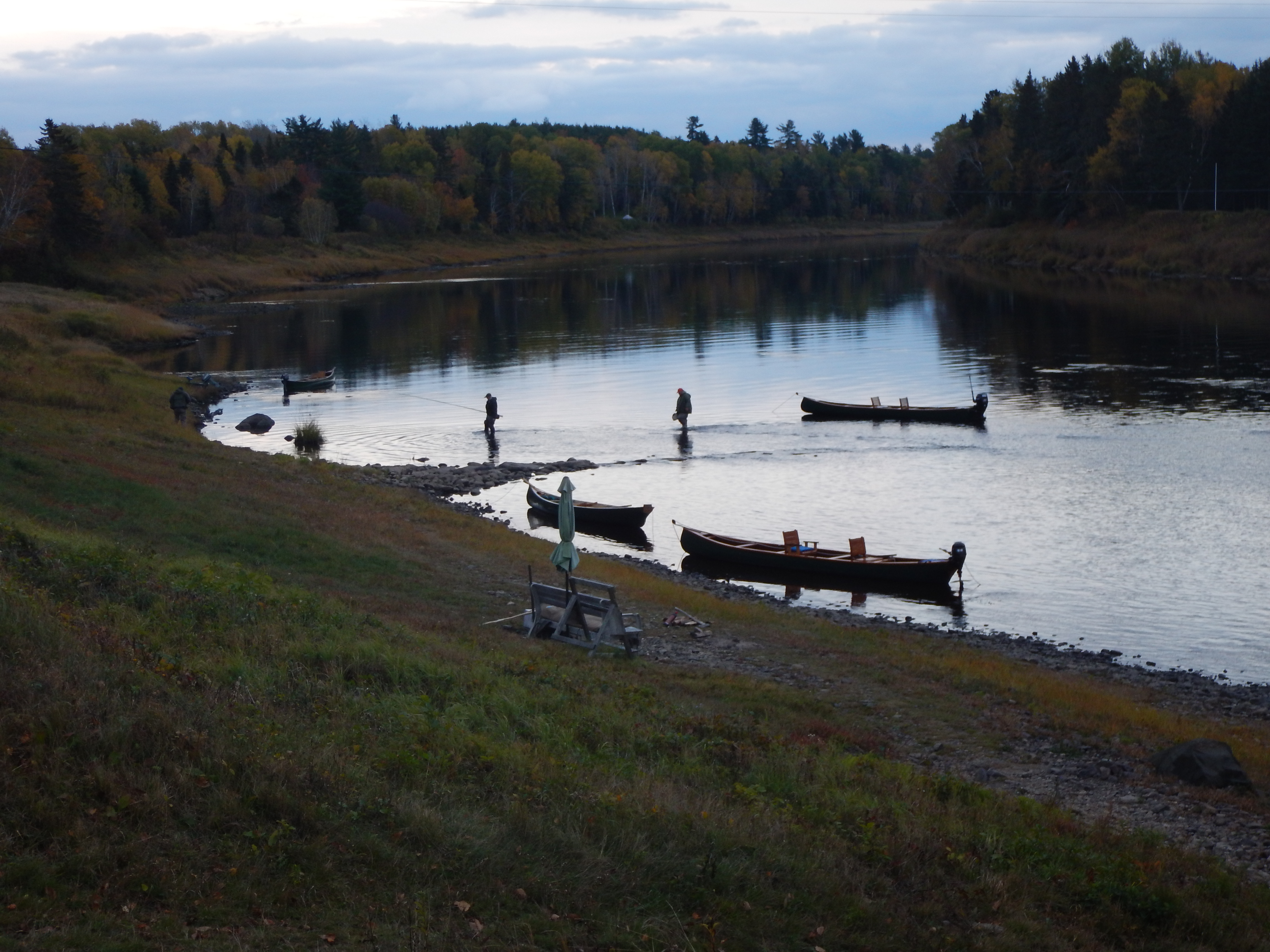
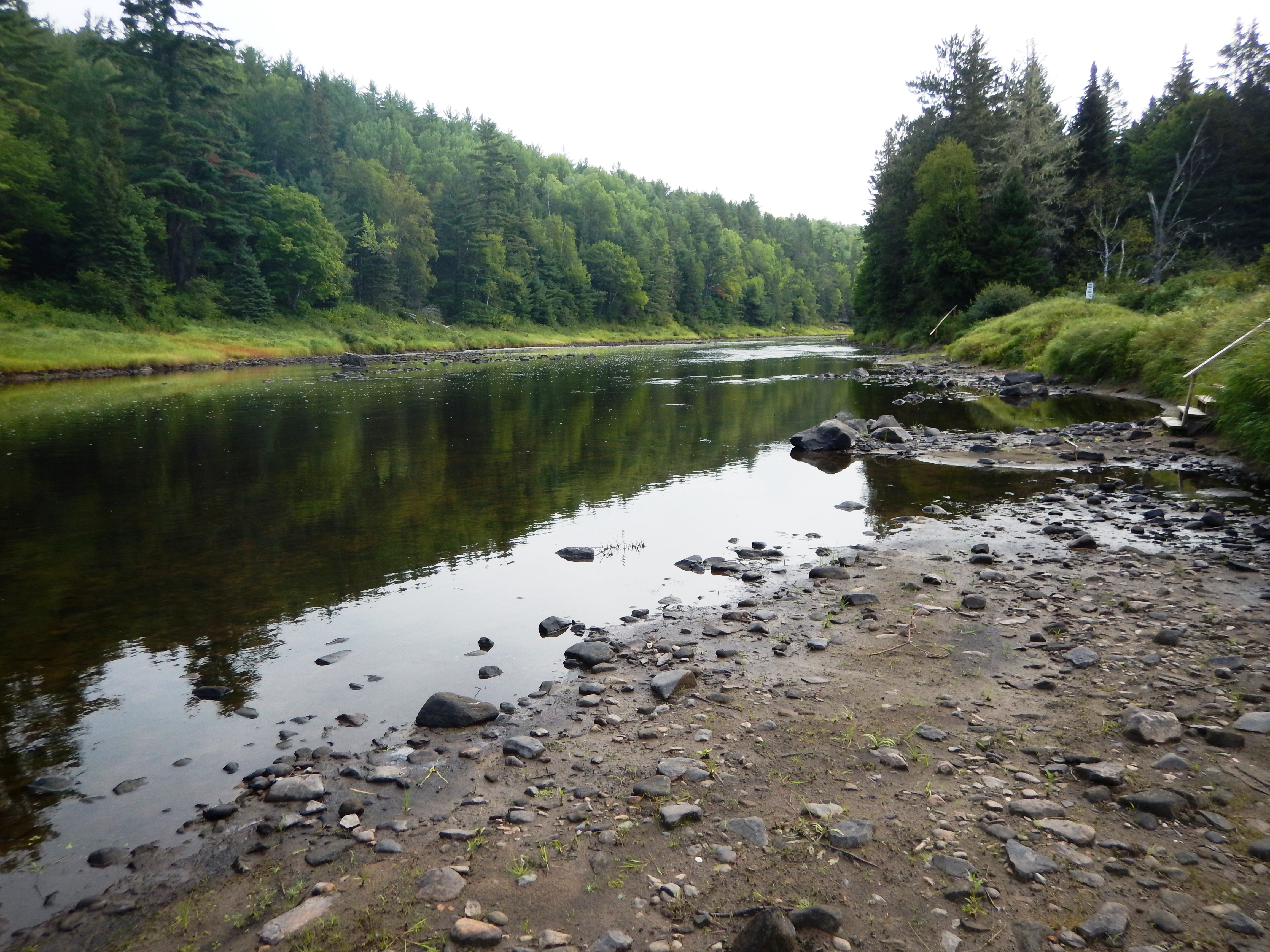
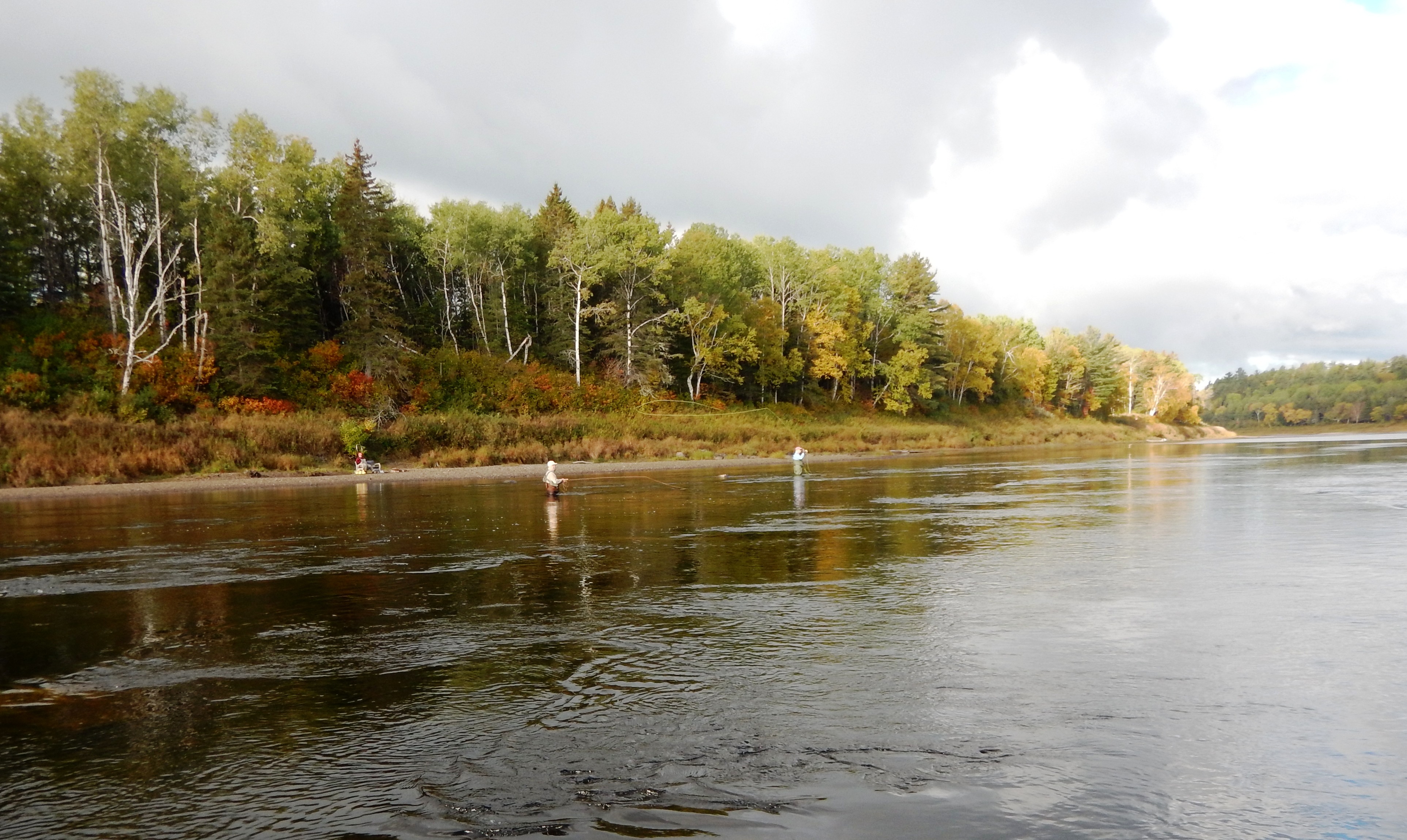

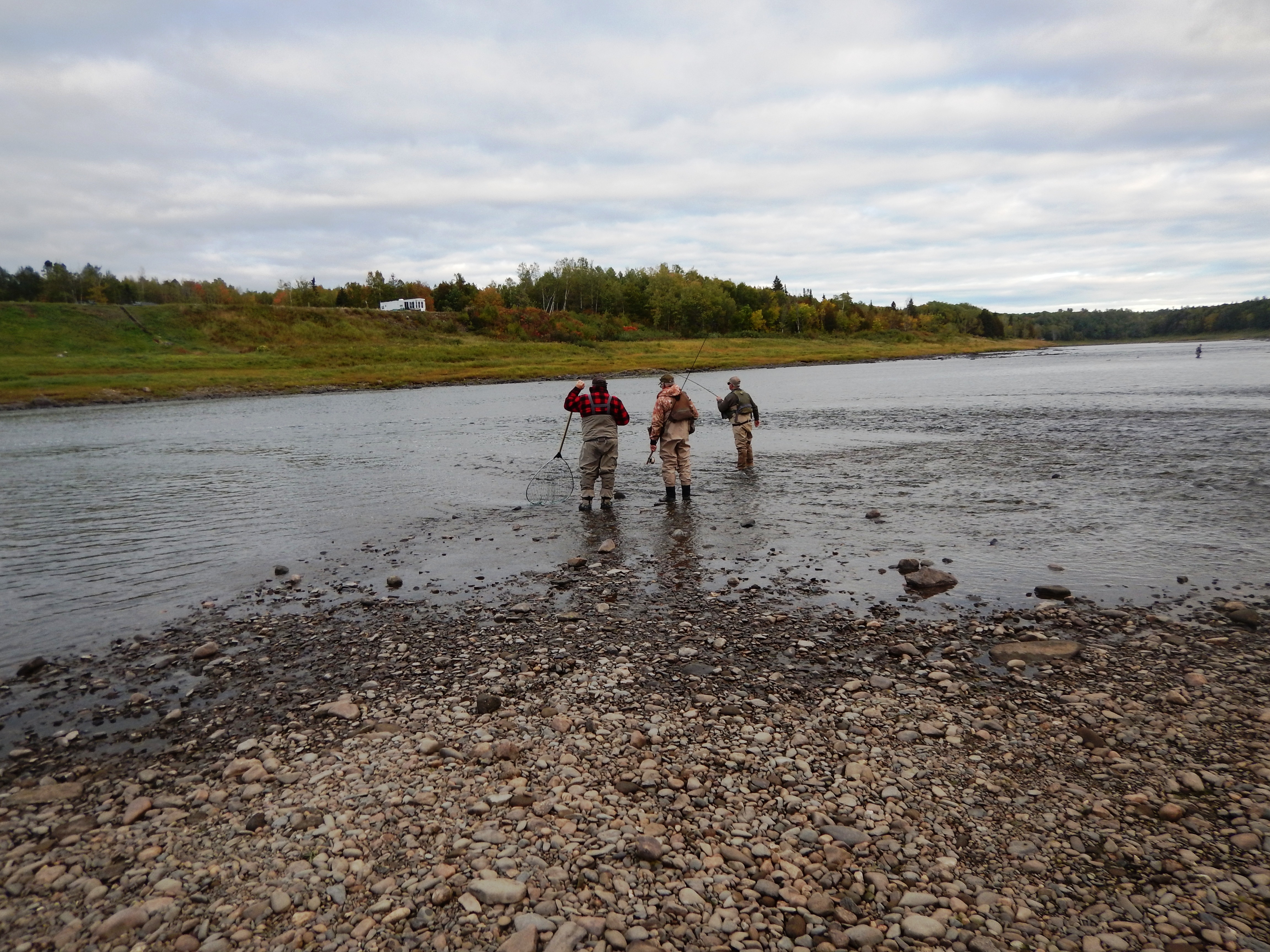
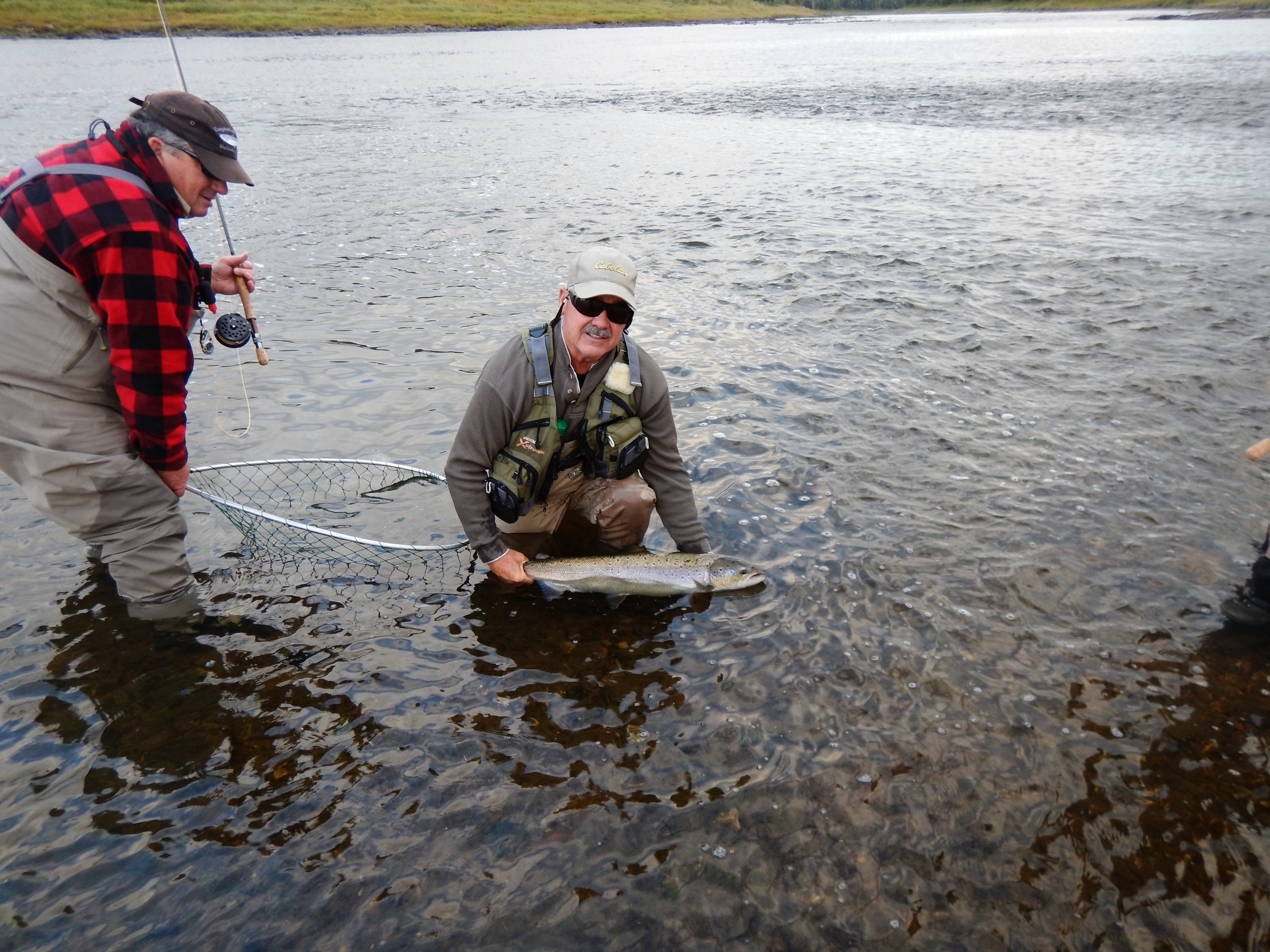
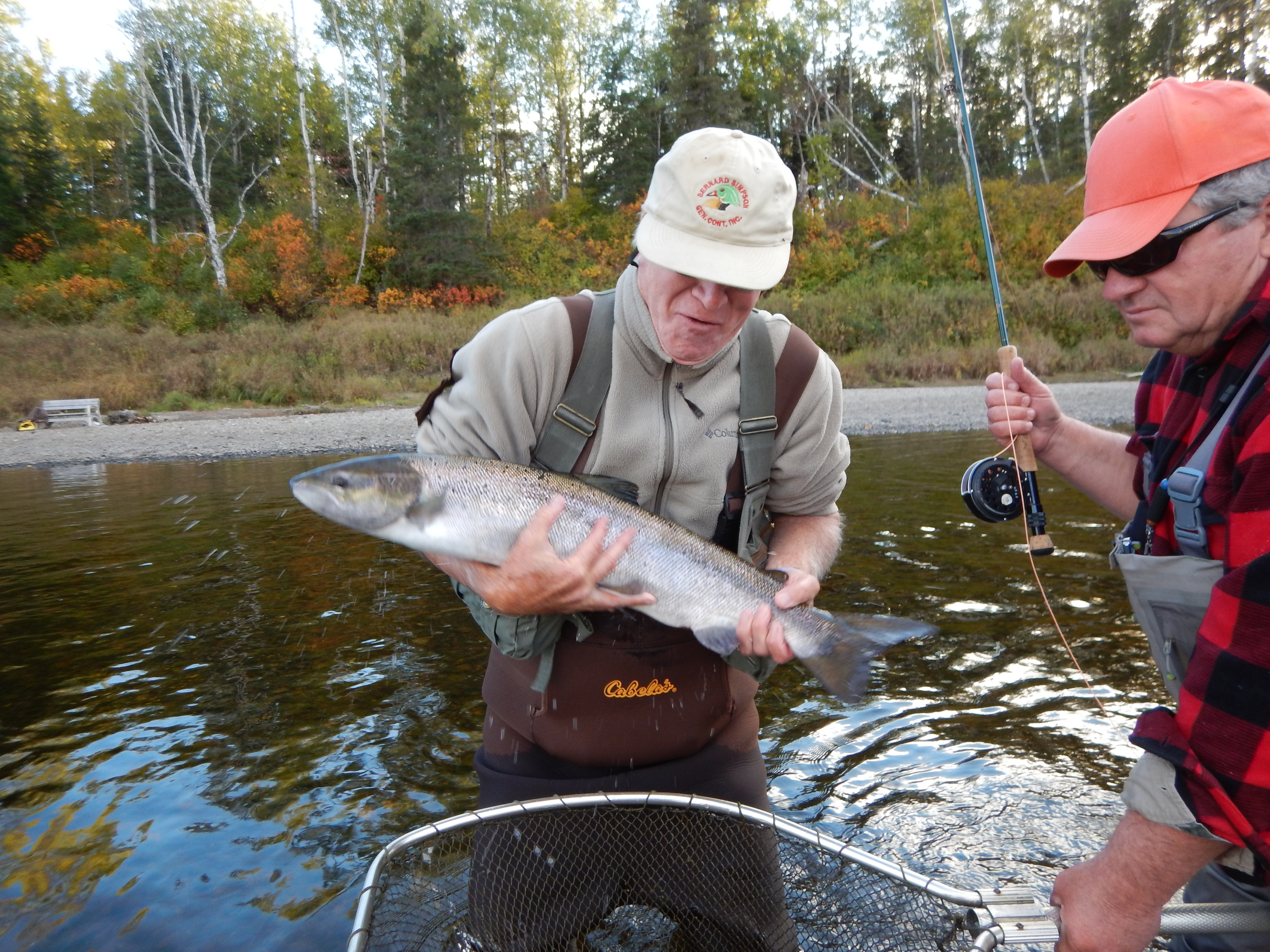

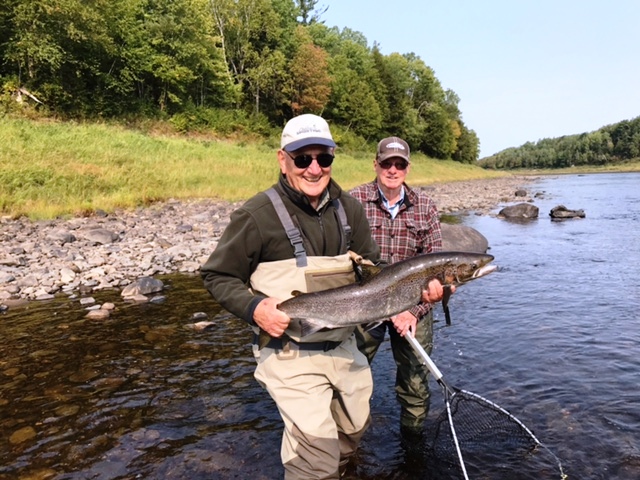
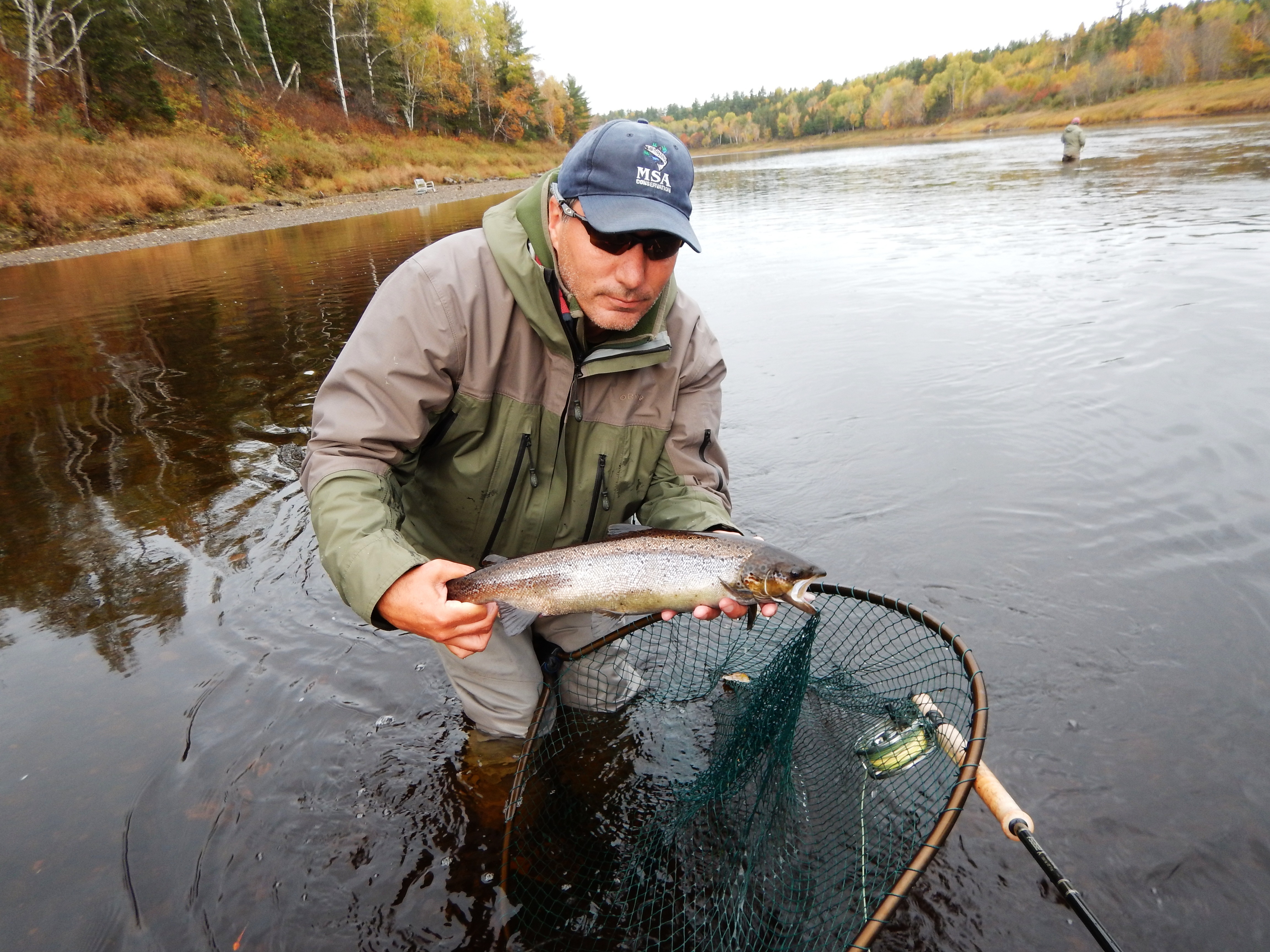
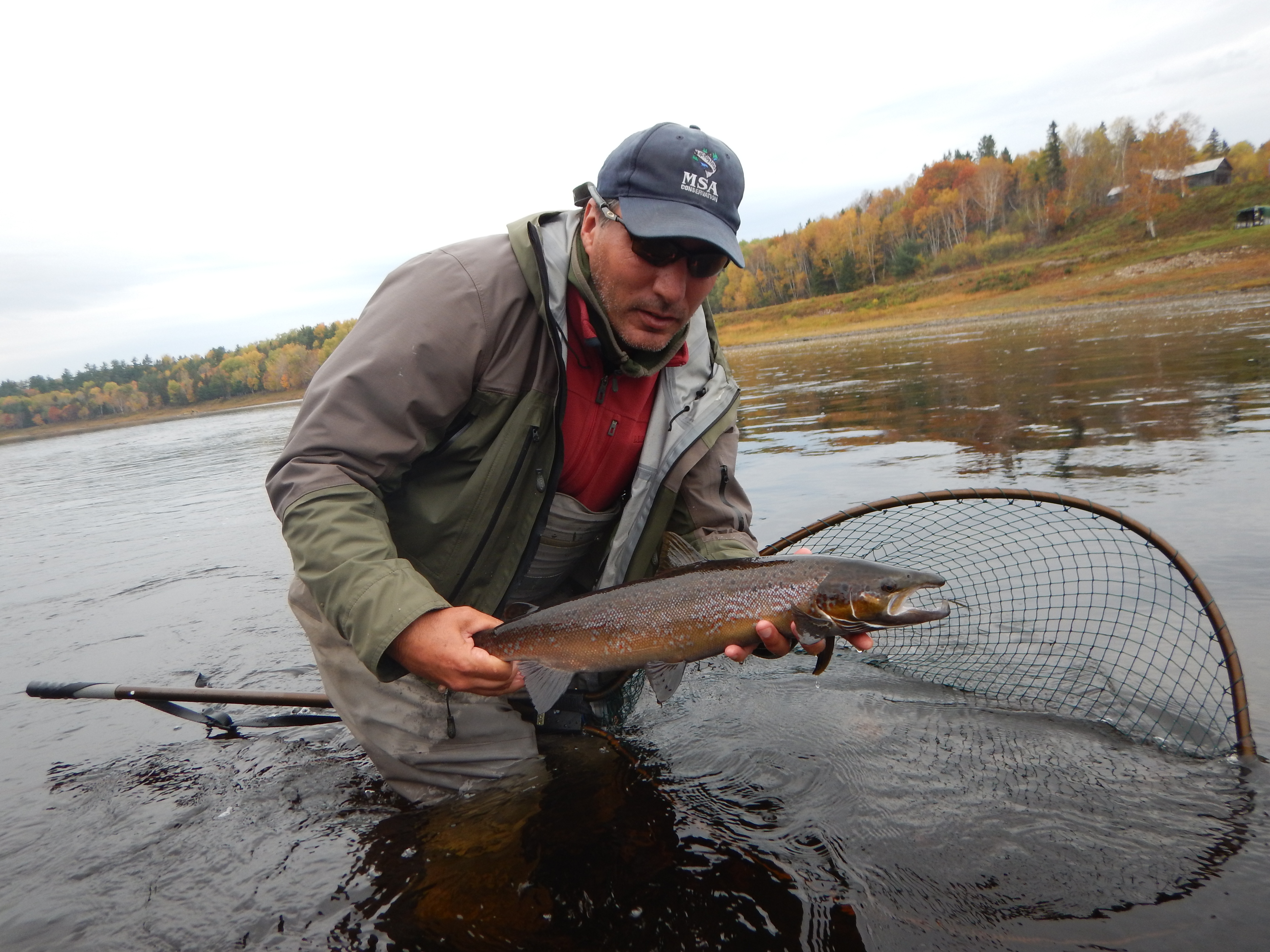
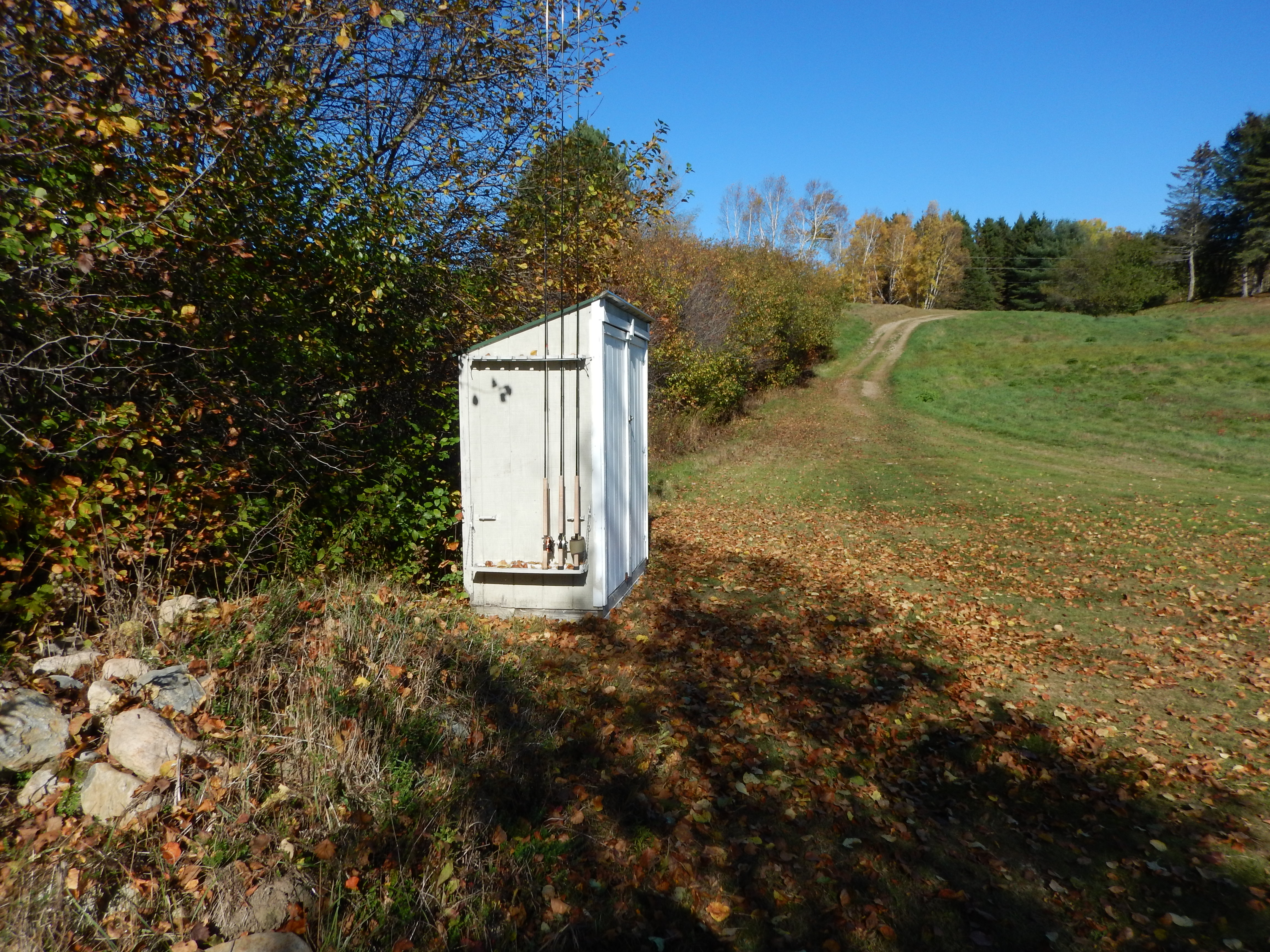
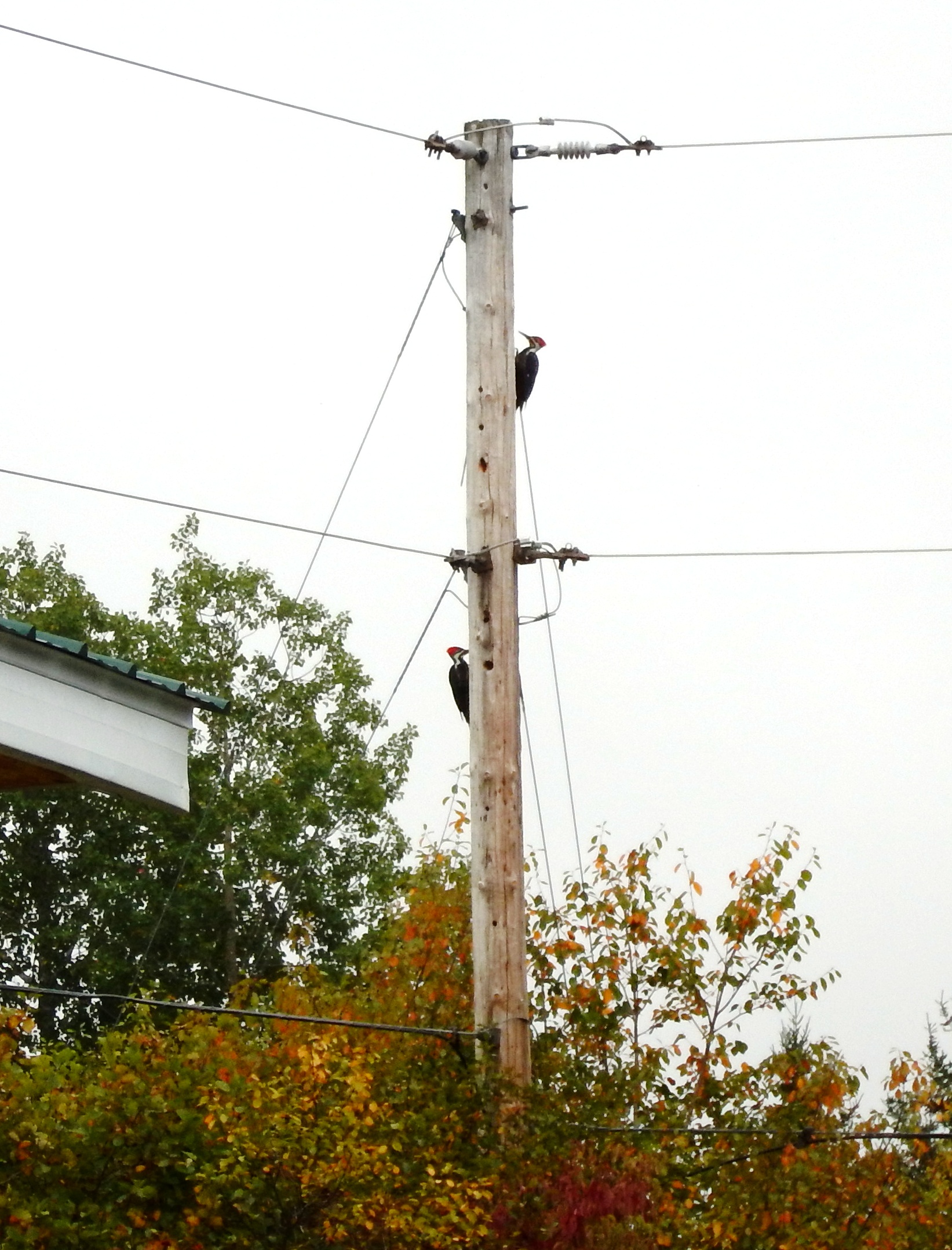
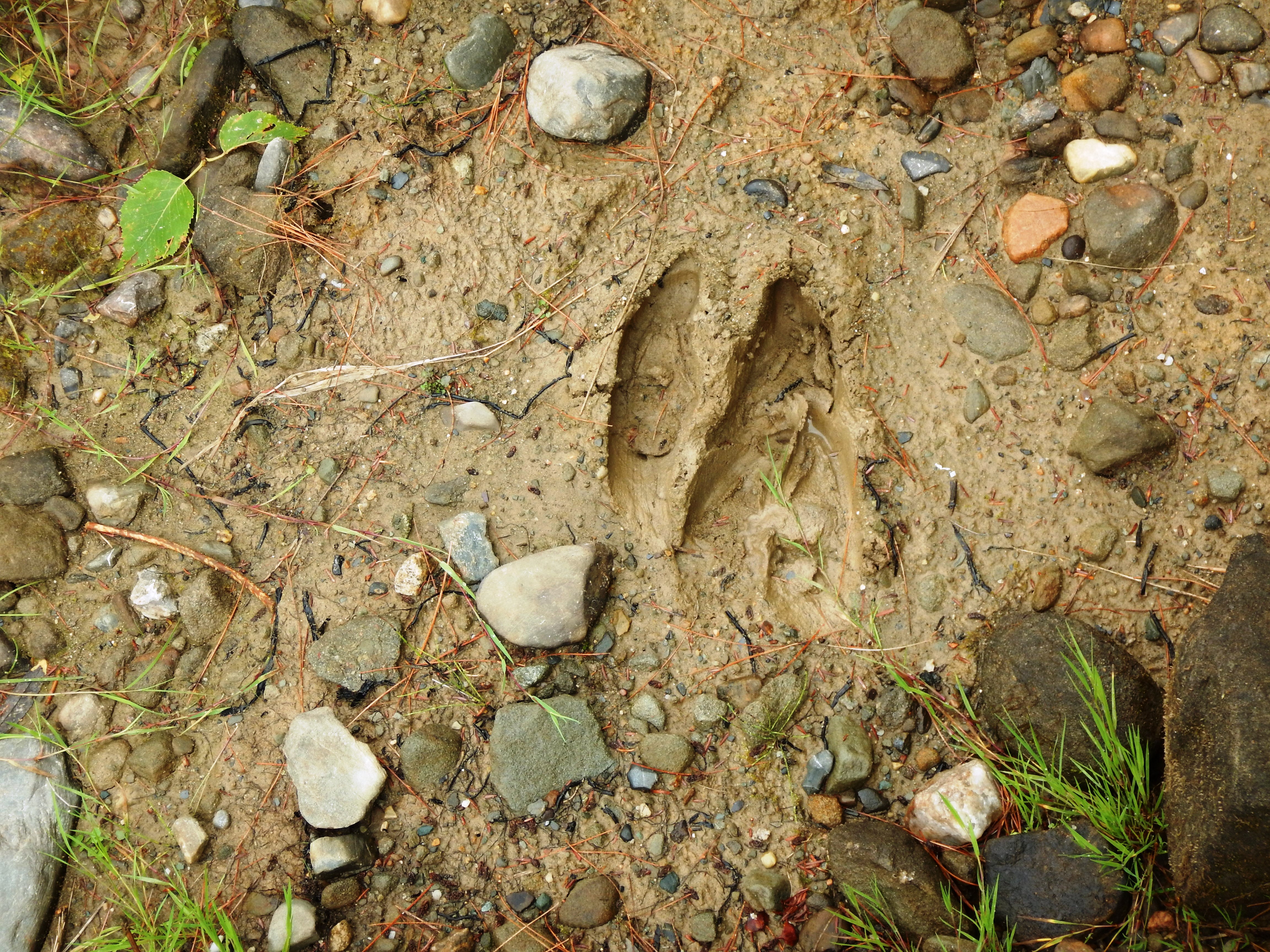
Even a bad day on the Miramichi system still beats the best day at work!
True enough Larry. I’ve been home 4 days and I’m having severe withdrawal pains. Some of the other rivers along the Northumberland shore of NB and NS are open for a few more days, but I have been away a long time…
The 3 of us fished Sept. 24th thru the 28th out of Country Haven. Landed one grilse and had a couple other fish show a little interest in a Bomber floated over them in Cheryl’s Pool but mostly it was 4 days of casting practice. However, I can’t think of a better place to be for 4 days. We’ll be back, probably a little later in the season, next year.
Robert – I wouldn’t hurry to give up dates of the 24th through the 28th. Over the last few years I’ve come to believe that the last week in September, all things considered, has the most dependable fishing of any week. This year we just had a terrible, season-long drought. Later is better for the Cains, especially above Muzzerol, but for the Main Southwest Miramichi, the last week in September is the safest guess you can make. Brad
It has been a while since your previous report Brad…………it was worth the wait !
Another great read and I am pleased to see that things picked up, all be it modestly, towards the close of the season.
As for the “withdrawal pains”…..you and me alike!
Here’s to next season.
Best
Nigel.
Great to hear from you Nigel. You sure have a much shorter wait than I do. I’ll be over your way in early March, and may very well extend my trip a little this year and fish the Thurso after the Naver.
You will be very welcome back on the banks of the Thurso River Brad, as you well know. Both myself and that old Heron from Wick,….along with many other’s I am sure, feel it will be well overdue!
Nigel.
Thanks Nigel. Had an e-mail from the Heron himself this morning. He said that he and one of his Irish buddies had 16 one day at the end of the season! Hopefully you got in on all that action. Please send us a few of the surplus…
Hey Brad-Great end of the season round-up. Like many, I will be interested in the final run numbers. I suspect that the counts may not be reflective of the actual run. First, because they are an index and will show general trends, but also because I suspect that a growing portion is coming later and later with the general warming trend and after the 31st.
Also, a couple of things on the Yum Yum. It was named the Crystal Yum Yum and I have to admit that I took that from one of our former guests, Jack Cornell. At dusk, he would announce that it was crystal yum yum time and head up the hill to make a martini. Because of the crystal flash, it seemed an appropriate name, although one does not have to wait til dusk to use it.
best bass fishing I have had even better than the cape
Rip – one thing I’m guilty of – and I suspect a lot of us are too – is putting flies into certain categories. I originally tied those big long Yum Yums on #2 hooks just for the June fishery. I had good luck with them, and you can get away with the big flies in the cool June water. It is also true that the Miramichi has a ton of big stone flies early on that the big YY may remind the salmon of. I just never thought of it as a fall fly, and never liked using it then. I guess I should re-think that given the success at BBSC.
Similarly we all gravitate to the red and orange stuff like the Chief Needabah and Ally’s Shrimp in the fall. The favorite early season fly in Scotland where every fish is chrome and usually have sea lice is the red, orange, and yellow Willy Gunn. Why not on the Miramichi?
Hi Brad- Thanks for your great reports. We finished up the season at Wilson’s with surprisingly good fishing but struck out on the Cains. Keep the faith , I am sure this is not the first year of low water and for sure won’t be the last. All the best, Keith , Karl and crew.
Thanks Keith. I’m glad you had good fishing. No one knows more about that upper Cains salmon fishery than you. It is too bad that season doesn’t last a couple of more weeks and give us more opportunity in years like this.
Thanks for another year of your fine blog, Brad. I look forward to your posts and enjoyed your book. Like all your readers, I’m counting down the days until next year’s fishing for trout and salmon in New Brunswick. I fished the Margaree in Nova Scotia at the end of September and saw lots of fish but didn’t have any hook-ups. I had good luck and exquisite timing to be on the Main Southwest Miramichi with Wilsons September 29-October 1 and managed a large salmon and a couple others. Hopefully that will be just enough to keep me going through the winter. I will try for some Great Lakes steelhead here in southern Ontario which will help. All the best.
Your post will make Keith happy…LOL. Glad you hooked up. A little more water and I think this would have been a helluva fall.
Hi Brad,
Reflecting on your end of season summary and your photo of our mutual friend Ralph Vitale wading up to his ankles made me wonder whether we should adjust our fishing seasons to reflect the new normal in terms of temperature and rainfall.
Great to hear from you Bill. I signed up for the same week on the Varzuga again, how about you?
Hopefully this is not the new norm. Just a very few years ago the Cains was our salvation in the face of very wet fall conditions year after year. I do think, though, that like a number of other Northumberland Shore Rivers the Cains and maybe even the Miramichi fisheries could benefit by extending their season another week or two.
Brad, thanks for the nice end-of-season synopsis.
Our last-week’s fishing took a surprising turn. Two friends and I went fishless on the Main SW and lower Cains from October 9-12. We did not see a fish on a kilometer-long stretch of the Main SW just above Blackville for a day and a half during that time.
We ended the season fishing a popular pool on the lower Cains. We were very lucky, netting two 15-ish pound salmon and a grilse. One of my friends got his first-ever salmon, a 15 pound hen. We saw several other fish hooked and caught during our time on the pool.
We left the Main SW on a great raise/fall, virtually without seeing a fish, and found the answers to our prayers on a very low Cains River. That’s salmon fishing … best wishes for your off-season.
Jim, great to hear that you had some quality fish on the Cains. It goes to show the mysterious ways of the salmon migration. The time you were seeing nothing on the Main SW we spent several mornings in a row under decent water conditions on the Cains only about one mile upriver from the mouth. We were seeing and hooking a fish or two daily in main river, and we expected to see some of those fish in the Cains. Instead of that we saw and caught nothing in the lower Cains and decided instead to spend the last few days concentrating on the main river. Sounds like we gave up on the Cains a little early. Additionally I have heard that a couple of good pools upriver a ways in Shinnickburn were starting to hold quite a few fish on the last day or two, so clearly they were on the move. Brad
Brad; Thanks for the recap. I follow your posts avidly. After a week of chasing Stripers in Rhode Island, two of us just got back from our last foray this year to Sault Ste Marine, MI and the St Marys River for the Great Lakes Version of Atlantic Salmon Fishing. We have lots of water here but the temperatures have been so high the river is still running warm. But, we did manage two Atlantics boated, one very small, but a native fish, not stocked and a mid-sized cockfish. There was another nice fish lost. As is common here, there were also two steelhead landed, one of nice size. Now it’s just steelhead fishing in Lower Michigan for us for the rest of the year. Not the great wild fishing you have there, but it suffices, and lasts all year.
Thanks for the comments Pete. Our wild fishery is pretty much over for the season. It would be nice to have something handy that bridged the seasons here.
For some very interesting salmon run information, log on to this website : http://www.castsalmon.com It gives you the daily numbers of both salmon and grilse passing through the sonar counters located just below the Blackville bridge.
Earle – I have been in touch with the folks at the UNB who have put together that website and are trying to figure out the data that appears there. The amount of passage both up and down river at the Blackville bridge location on the MSWM makes it quite a task to figure out the net upriver run of salmon and grilse. Because of that they only have the MSWM numbers updated through August, and they tell me it will the end of November before they get it caught up. It will be very interesting, though, to compare the numbers coming out of Millerton and the camera counts.
Yes Dave we landed 40 Striped Bass on # 10 Undertakers some 3 ft long & seen thousands in White Rapids on Oct 8th
Good evening, just picked through your excellent site and enjoyed it much.
Does anyone fish the Bartholomew River these days? Or does that stream also fall victim to the low water conditions?
Can one describe to your report, (thus receiving it automatically) ?
Tight lines to all! <°))))<<
John – home page of my website has button in shape of a fish to subscribe to bog notice list n/c.
There is very little local discussion of the Bartholomew. I do understand that it requires a raise of water to bring in the fish. Brad